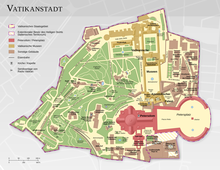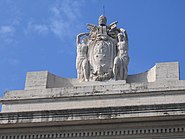Città del Vaticano train station
| Città del Vaticano | |
|---|---|
|
Reception building
|
|
| Data | |
| Operating point type | railway station |
| Location in the network | Terminus |
| Design | Through station |
| Platform tracks | 1 |
| opening | 1929/1933 |
| Architectural data | |
| architect | Giuseppe Momo |
| location | |
| City / municipality | Vatican city |
| Country | Vatican city |
| Coordinates | 41 ° 54 '4 " N , 12 ° 27' 4" E |
| Height ( SO ) | 17 m |
| Railway lines | |
|
|
The Città del Vaticano station is the station of the Vatican City and is designed as a terminus . The railway facilities are operated by the Vatican State Railway Company Ferrovia Vaticana and at the same time represent the company's entire route network .
railway station
The layout of the station is quite simple: it has two parallel tracks , one of which is the platform track. There are two short butt tracks branching off from this , on which freight wagons that are to be unloaded can be parked.
The tracks lie in a wide, flat hollow in the middle of the Vatican gardens . In order to achieve the necessary track length, the entry point and the first meters of the two tracks are still on Italian territory.
To enable maneuvering , the pull-out track at the head end of the station had to be laid with its end in a tunnel stump that leads 97 meters into the hill to the west of the station .
The course of the system is set by hand. There is a telephone and telegraph connection to the neighboring Roma San Pietro train station , where the tracks join the Pisa – Rome railway line .
Reception building
That of Giuseppe Momo, the court architect of Pope Pius XI. 1933 built station building , stands on the single platform of the station in a lateral position. The platform begins immediately behind the gate, which allows the entrance track through the Vatican ramparts. The station building reflects the neoclassicism customary at the time and is oversized in view of its importance in terms of transport technology. The supporting structure is made of reinforced concrete . The building occupies a floor area of 61 meters by 21.5 meters, the central risalit is 17 meters high. Originally there was a platform roof on the track side, which corresponds to a covered right of way for cars on the street side .
As it was originally planned as a train station for state receptions, the building received a splendid interior decoration of the central reception hall in different colored marble , a stucco ceiling and eight monolithic columns made of green marble. Offices and operating rooms were arranged to the side of the central hall.
The exterior is largely clad with travertine ; on the platform side, artificial travertine was also used in higher areas. The sculptural decoration on the street side of the building comes from Professor Eduardo Rubino:
- The coat of arms of Pius XI, supported by two allegorical figures (thought and deed), above the central portal
- On the side wings two reliefs with biblical scenes on the subject of "travel":
Since the reception building was almost never used for its actual function, it is now largely used for other purposes. In the 1990s, a false ceiling was put in the central reception hall and the effect of the room was destroyed. A noble duty free shop Magazzino (for employees and residents) and a coin and postage stamp museum on the first floor were housed there. The platform roofing has also been removed in recent years.
reception
There are different opinions regarding the architectural value of the building:
From Pope Pius XI. On the occasion of a construction site visit, the quote is handed down: "This is the most beautiful station building in the world!"
The writer Henry Vollam Morton, however, said it looked like a branch of Barclays Bank in London.
use
The use of the reception building was a rare occurrence from the start. During the planning and construction, those involved assumed that glamorous state receptions would take place here. That never happened.
The first Pope to personally use the station was John XXIII. : On October 4, 1962 - a week before the opening of the Second Vatican Council - he used it for a pilgrimage to Loreto and Assisi . The special train borrowed from the Italian President for the occasion served as the vehicle .
Since Pius IX. was the last Pope who had visited Loreto - still as head of state of the Papal States - and was the last Pope to take the train or to have stayed outside the walls of the Vatican, this trip was a symbolic break with the tradition of aversion to the world and Openness to the world is valued.
Pope John Paul II used the train a few times as a starting and ending point for trips within Italy :
- On November 8, 1979 - rather symbolically - for a trip to the Roman train stations Salario , San Pietro , Trastevere and Roma Termini on the occasion of the "Day of the Railway Workers" and a meeting with shunters in the Salario train station.
- 1986 when he returned from his visit to India , because his plane could not land in Rome because of the snow , but in Naples , from there he took the train back to the Vatican.
- On January 24, 2002 on a pilgrimage to Assisi.
Pope Benedict XVI used the station on October 27, 2011 on the occasion of his train journey to Assisi for the world peace meeting.
In addition, external special trains occasionally run to the station, such as an excursion by the German Society for Railway History on October 2, 2008.
Since September 2015, a tourist train has been running on Saturdays at 10:57 a.m. from Città del Vaticano station to the papal residence Castel Gandolfo , which can be visited after this trip. On the way back, the journey ends at Roma San Pietro train station . This tourist offer is a collaboration between trenitalia and the Vatican Museums.
Other passenger traffic is extremely rare and limited to a few special trains . Rail freight traffic, on the other hand, is regularly handled via the train station.
Picture gallery
literature
- Ministero dei Lavori Pubblici del Regno d'Italia: La ferrovia per lo Stato della Città del Vaticano . Roma, Istituto Poligrafico dello Stato, 1934.
- G. Pini: La ferrovia della Città del Vaticano . 1934
- F. Zanetti: Dalle prime ferrovie dello Stato Pontificio a quella dello Stato della Città del Vaticano . In L'Illustrazione Vaticana 3 (1932), pp. 376-378
Web links
Individual evidence
- ^ Film of the first locomotive entry into the train station and the tunnel stump
- ^ Reese, Thomas J. 1996. Inside the Vatican: The Politics and Organization of the Catholic Church . Harvard University Press. ISBN 0-674-93261-7 . p. 203.
- ^ Tilmann Kleinjung: Much visited and yet unknown . In: Deutschlandradio Kultur . 2011 ( dradio.de ).
- ^ Frank J. Korn: A Catholic's Guide to Rome: Discovering the Soul of the Eternal City . Paulist Press, 2000. ISBN 0-8091-3926-X .
- ↑ Bernard P. Prusak: The Church Unfinished: Ecclesiology Through the Centuries . Paulist Press 2004. ISBN 0-8091-4286-4 . P. 271.
- ^ Pope travels to Assisi by train, with representatives from all major religions. In: YouTube. ROME REPORTS, accessed September 20, 2015 .
- ↑ pall: Another new design for Italian multiple units . In: Eisenbahn-Revue International . No. 12 , 2011, p. 609 .
- ↑ Drive to the papal summer residence. Swiss Radio and Television (SRF) broadcast Kulturplatz from November 30, 2015 , accessed on November 8, 2018 .
- ↑ Timetable and details in: gwa / ser / rdi / khe: Vatican City. Roma San Pietro - Città del Vaticano route . In: IBSE Telegram 298 (9/2015), p. 6.
- ↑ New service: With the Pope train to Castel Gandolfo. In: spiegel.de. September 12, 2015, accessed September 13, 2015 .
- ^ Vatican Full Day on the train. Vatican Museums, accessed November 8, 2018 (description of the offer and online ticket sales on the official website of the Vatican Museums).
- ↑ The offer on the trenitalia website












